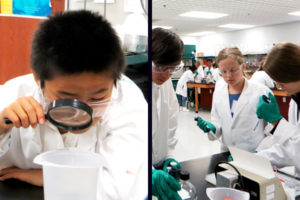 Within science education, teaching Scientific Inquiry to students has gained both traction and prominence. Teachers are increasingly being called to teach students not only science content, but how to take the concepts of the scientific method and put them into action; to think and to act like scientists. As Karin Borgh pointed out in last month’s blog, teachers invariably run up against the limitations of time and resources as they strive to get their students to enact science. When a teacher brings students to the BTC Institute, they gain access to some of those resources and, on a field trip-basis, a little bit more of that luxury of time.
Within science education, teaching Scientific Inquiry to students has gained both traction and prominence. Teachers are increasingly being called to teach students not only science content, but how to take the concepts of the scientific method and put them into action; to think and to act like scientists. As Karin Borgh pointed out in last month’s blog, teachers invariably run up against the limitations of time and resources as they strive to get their students to enact science. When a teacher brings students to the BTC Institute, they gain access to some of those resources and, on a field trip-basis, a little bit more of that luxury of time.
The BTC Institute’s K-12 programs have been focused for more than twenty years on coaching students to think and act like scientists. Most of our Biotechnology Field Trips options seek to maximize the resources and time we have with students to present complex tools and processes that they, in many cases, can only get while here: how to use a micropipette, what PCR is and how it’s used, what happens when we put a new gene into bacteria. Even with the luxury of time that we have with students we, more often than not, are pushing against the limits of that time to deliver the highest-quality content that we can.
This autumn, we’ll introduce a field trip that focuses less on pushing more complex concepts and techniques, and more on the process of scientific inquiry. Students will use household ingredients to extract DNA that they can see from fruit. Using a provided method as a control, they will select one variable to change in a second method, forming the basis of their experiment. By putting the steering wheel into students’ hands, we’ll allow them to drive their own exploration within the lab.
That’s what science is at its core. It’s coupling imagination and observation to the attention-to-detail stuff like experimental method and technique. For many of us who have built a career in science, that sense of wonder can be tapped into again and again… and it’s what keeps laboratory work from becoming drudgery.
When working in the outreach lab with middle school and high school (and sometimes our adult MTBNS participants 😊), it’s right around the time that students are first getting their labcoats and goggles on that I often hear them say, “Wow! I feel like a real scientist!” Their sense of enthusiasm and wonder always makes me grin. Whenever I hear a student say that, I try to provoke their imagination to take the next step. I remind them, explicitly, that they not only look like a scientist, but they will soon have an opportunity to think and act like a scientist, as well.
Sound Interesting? Check out what we’re up to at the BTC Institute… and join us for a course, if you can!
Latest posts by Ryan Olson (see all)
- Modeling Scientific Inquiry - September 17, 2018
